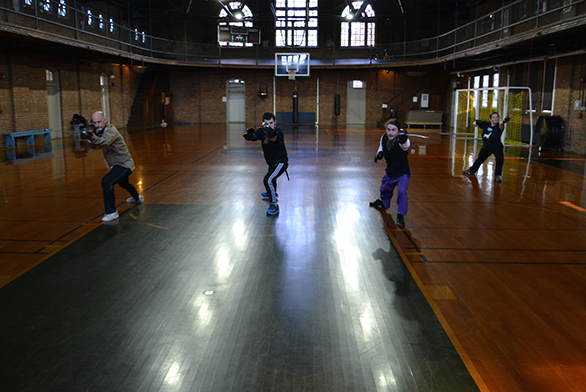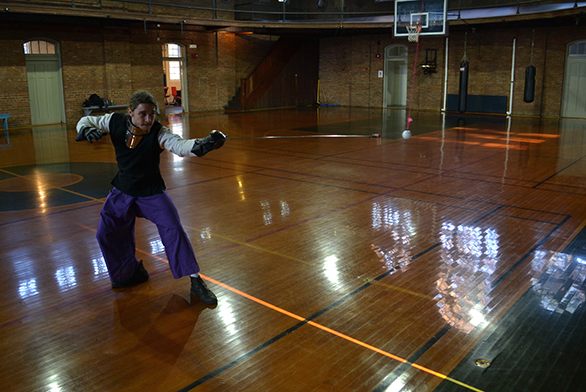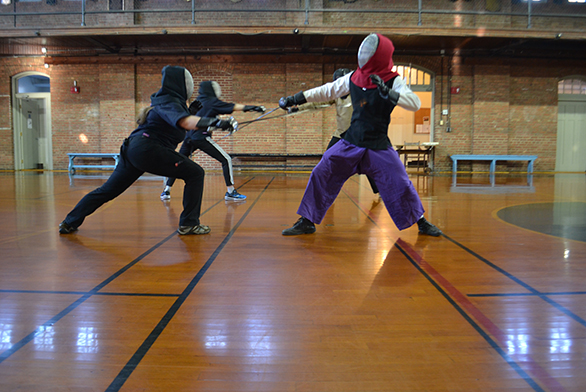Johnnies Go Medieval
December 8, 2016 | By Tim Pratt

As the sun shined brightly through the windows in Iglehart Gymnasium, the clanging of rapiers echoed through the building.
St. John’s College students, donned in steel mesh masks and other protective gear, maneuvered left and right on the hardwood floor, lunging, twisting and turning with their weapons in hand. They were striking and defending, but also analyzing and learning.
This is Historic European Martial Arts, a practice that dates back centuries, but has recently grown in popularity in the U.S. and on the St. John’s campus in Annapolis.
Although the HEMA club has only evolved over the last half-decade, funding from the student Delegate Council this year allowed it to purchase more equipment. The goal is to attract more participants, get even more gear and continue to grow, says senior Charlie Denton, the head instructor.
“If you ever thought that Medieval combat was just fantasy, we like to prove the contrary,” Denton says.
HEMA practitioners aim to learn and teach historic sword-fighting techniques as they were recorded in manuals throughout the Medieval period. It is practiced all over the world, though it is especially popular in Europe.
The club is similar to the fencing team, though there are a number of significant differences. Team members swordfight and wear masks of steel mesh, but the weapons and approaches are very different.
The replica rapiers and long swords used in HEMA are much heavier than fencing foils, sabers and epees. Shields can also be used. And while fencing participants are restricted to more linear movements, those who practice HEMA are allowed to move about more freely.

The HEMA club studies translated copies of manuscripts dating back to the 1300s and earlier, learning martial techniques almost entirely within the context of primary historical sources.
During this practice, Denton went over a number of different fencing techniques from 17th-century Italian Master Ridolfo Capoferro. Before that, the club did Tai chi to warm up. Then they grabbed their swords and performed lunges, striking golf balls hanging over the edge of the gym floor from an upstairs railing. Weight training followed before they moved on to Capoferro’s techniques and sparring.
No experience is necessary to join the club, though beginners will learn stances and techniques before they are allowed to spar with fellow members, Denton says. Tai chi is important for beginners as they learn to move in ways that are less taxing on their joints.
HEMA is also a sport that takes mental fortitude. Denton likens it to a chess match, where participants are analyzing their opponents, their blade positions and opportunities to strike.
Points are awarded for strikes. But the club also plays by “black knight rules,” Denton says, in which participants are not allowed to use a limb if they are “cut” there. If you’re cut in the arm, for instance, you lose the use of that arm. If you’re struck in the chest or head, you’re “dead,” Denton says.
“Most often, if people have never seen this before, they’ll be caught off-guard a little bit,” Denton says. “They’ll think, ‘Is this for real?’ But if they like history, if they like crafting, if they like sports in general, this is an athletic pursuit that combines all of those things.”
While some members have bought or crafted their own equipment, the funding from the Delegate Council has allowed the club to purchase additional pieces. Denton hopes more funding in the future will allow the club to outfit more students.

Freshman Thomas Chrisman says he knew a bit about HEMA before arriving at St. John’s. He also had an interest Medieval and ancient warfare. So he jumped at the opportunity to practice HEMA at St. John’s.
“It’s really the first athletic activity I’ve ever joined,” he says.
Archon Erin Compton, a sophomore, has been a club member since last year. She says the club has many appeals.
“It combines history with physical fitness,” she says. “I like it a lot.”
The club has a demonstration, dubbed “A Day of Duels,” set for 1 p.m. December 14 on the quad.

